General election 2019: Ten seats to watch in Scotland
- Published
- comments
The snap general election campaign is now in full swing ahead of voting on December 12. Here are 10 constituencies in Scotland which could tell the story of the contest.
1. North East Fife

This part of Fife recorded an above-average Remain vote, even by Scottish standards
2017 general election: SNP hold (0.1% majority)
Referendums: 55% No; 64% Remain
Target for: Lib Dems
Contestants: Wendy Chamberlain (LD); Stephen Gethins (SNP); Wendy Haynes (Lab); Tony Milinski (Con)
This seat was held by the narrowest margin in the entire of the UK in 2017, with the SNP's Stephen Gethins seeing off a Lib Dem challenge by just two votes - after three recounts.
The Lib Dems have thus had their eye on this as a target for some time. They selected their candidate, Wendy Chamberlain, in June 2018.
The SNP and Lib Dems are locked in a fierce battle for the backing of pro-European voters - particularly here, given the above-average Remain vote in the area.
So the result in this squeakiest of seats will answer a lot of questions about this election. Whose vote is going up and whose is going down, how much tactical voting is going on, and who can capitalise best on pro-European votes?
2. Gordon
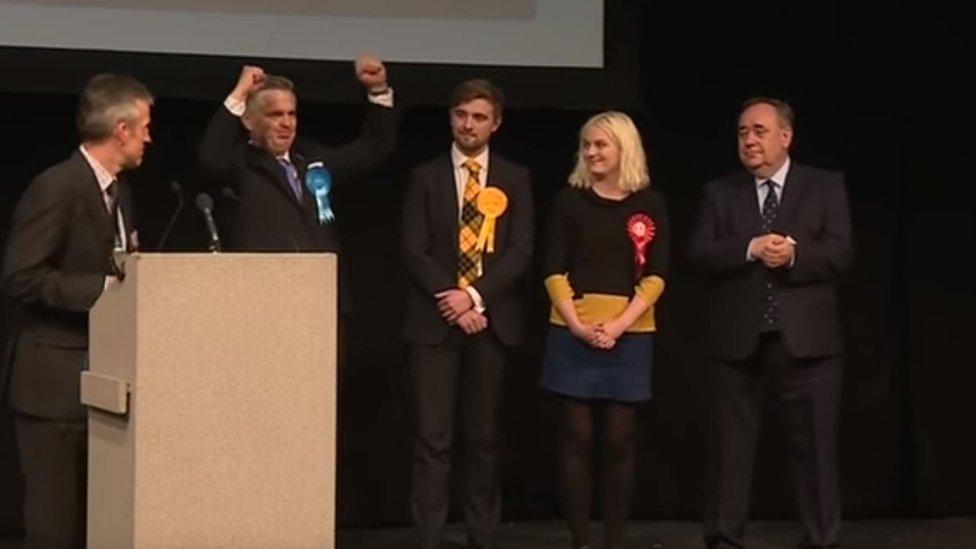
Colin Clark took Gordon for the Tories in 2017 - at the expense of Alex Salmond
2017 general election: Conservative gain from SNP (4.9% majority)
Referendums: 60% No; 62% Remain
Target for: SNP; Lib Dems
Contestants: Colin Clark (Con); Heather Herbert (Lab); James Oates (LD); Richard Thomson (SNP)
One of the big Scottish stories of election night in 2017 was former SNP leader Alex Salmond losing his Gordon seat to Tory Colin Clark.
The exit poll had actually predicted the seat could fall - to the Lib Dems, who had held the seat for 30 years before Mr Salmond came along.
So can the Tories hold on to it this time, in the post-Ruth Davidson era? And if not, who might take it - the SNP, or the Lib Dems?
This seat could tell us a lot about how big an impact tactical voting by backers of the pro-UK parties is going to have. In 2017, the Lib Dem vote plummeted while the Tory one jumped, with the target of taking a big scalp in Mr Salmond.
But without that incentive to unite them, will former Lib Dem backers in the north east turn out for what is now the party of Boris "Brexit do or die" Johnson?
3. Lanark and Hamilton East
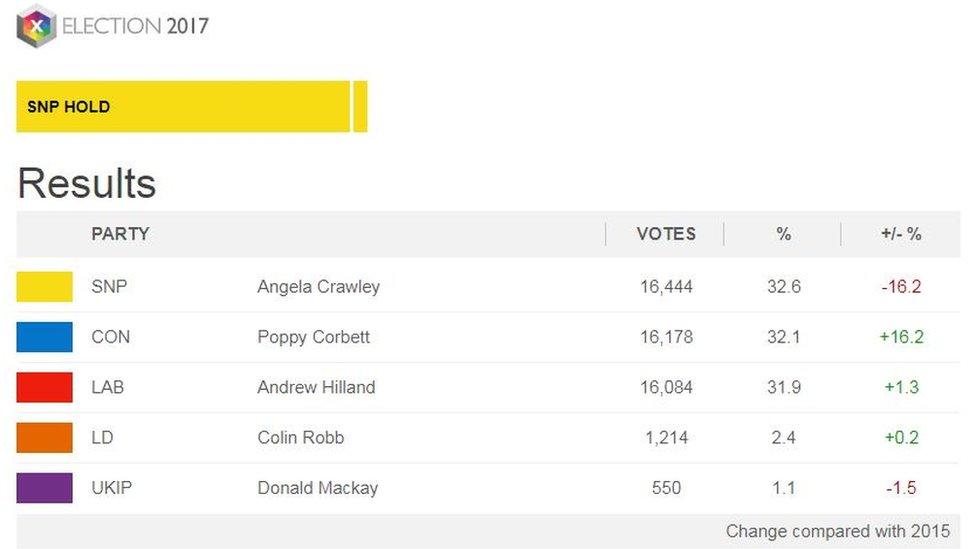
There were fewer than 400 votes between the SNP, Labour and the Tories here in 2017
2017 general election: SNP hold (0.5% majority)
Referendums: 58% No; 65% Remain
Target for: Labour; Conservatives
Contestants: Angela Crawley (SNP); Shona Haslam (Con); Andrew Hilland (Lab); Jane Pickard (LD)
This seat was held by the SNP in 2017, with the Conservatives in second place and Labour in third.
What that doesn't tell you is how close all three parties were to taking the seat - polling 16,444, 16,178 and 16,084 votes respectively. To put it another way, that's 32.6%, 32.1%, and 31.9%.
This kind of three-way contest is more common in Scotland than elsewhere in the UK. The House of Commons Library listed 38 such hotly-contested marginal seats, external around the country in the 2017 election, and 30 of them were north of the border.
The seat also tends to declare relatively early (about 03:00) so is worth watching out for as an indication of how these three big parties are performing.
4. Stirling
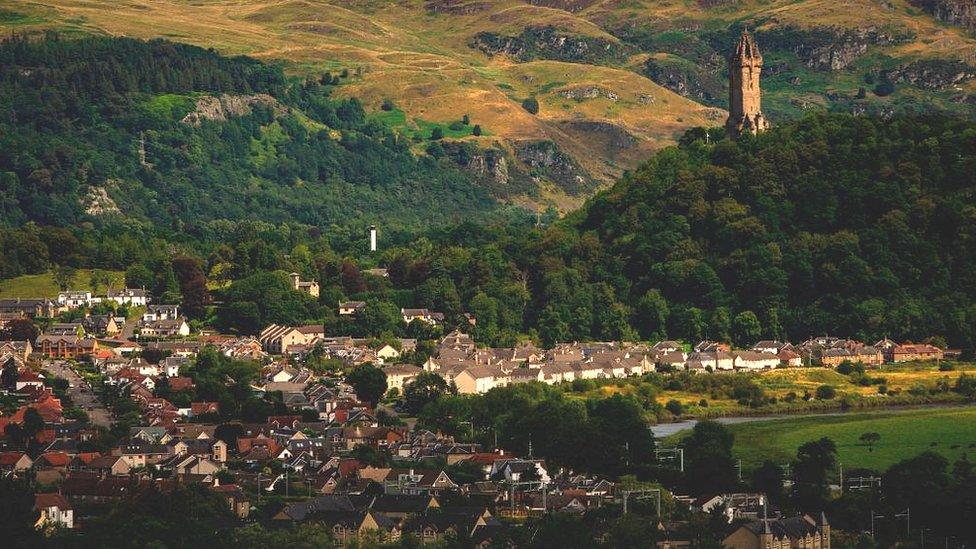
The SNP have made no secret of the fact Stirling is their number one target seat in Scotland
2017 general election: Conservative gain from SNP (0.3% majority)
Referendums: 60% No; 68% Remain
Target for: SNP
Contestants: Stephen Kerr (Con); Bryan Quinn (Green); Fayzan Rehman (LD); Mary Kate Ross (Lab); Alyn Smith (SNP)
The Conservatives took Stirling from the SNP in 2017, but Stephen Kerr's majority is just 148 votes.
This is undoubtedly the SNP's number one target seat. They have selected MEP Alyn Smith to fight it, and Nicola Sturgeon headed there on the very first day of the campaign. The Tories will be equally determined to hold it.
The area voted strongly to Remain in 2016, even by Scottish standards, but also recorded an above-average No vote in the 2014 independence referendum.
The result here should tell us a lot about how well equipped the Tories are to hang on overall - and also about the extent to which the Greens might attract some pro-independence voters.
5. East Dunbartonshire

The Lib Dems are talking up Jo Swinson as a future prime minister - but will she even be an MP come December 13?
2017 general election: Lib Dem gain from SNP (10.3% majority)
Referendums: 61% No; 75% Remain
Target for: SNP
Contestants: Amy Callaghan (SNP), Rosie Dickson (Ind); Pam Gosal (Con); Donald Mackay (UKIP); Liam McKechnie (Scottish Family Party); Callum McNally (Lab), Carolynn Scrimgeour (Green), Jo Swinson (LD)
This seat is currently held by the UK leader of the Lib Dems, Jo Swinson. However she's lost it once to the SNP before - could a repeat be on the cards?
In 2015, when John Nicolson took the seat for the SNP, the constituency had the highest turnout in the entire of the UK, at just shy of 82%. Will that hold up on a cold, dark December day?
After retaking the seat in 2017, Ms Swinson's majority is one of the healthiest in the country. She has since gained the profile of becoming her party's leader - but that also carries the risk of her being a big scalp for her opponents.
Voters here also have the widest range in choice in Scotland at this election, with eight different options on the ballot paper.
6. Ross, Skye and Lochaber
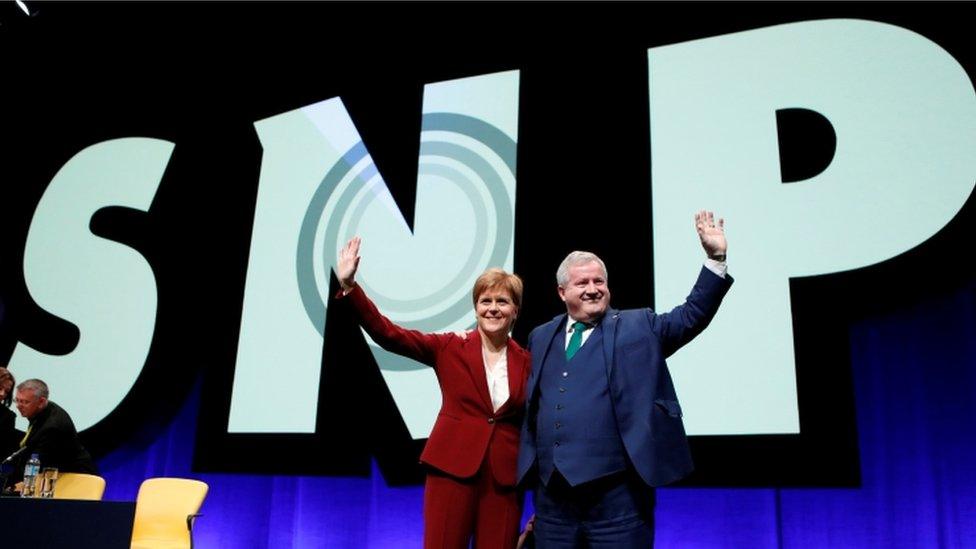
Nicola Sturgeon has already warned of a "plot" between other parties against her Westminster leader Ian Blackford
2017 general election: SNP hold (15.4% majority)
Referendums: 53% No, 57% Remain
Target for: Lib Dems
Contestants: Gavin Berkenheger (Con); Kate Brownlie (Brex); Ian Blackford (SNP); Donald Boyd (Scottish Christian Party); John Erskine (Lab); Craig Harrow (LD); Richard Lucas (Scottish Family Party)
Just as the SNP would love to knock off the Lib Dem leader in East Dunbartonshire, the Lib Dems have their eye on the SNP's Westminster leader in Ross, Skye and Lochaber.
This was a safe Lib Dem seat in 2010, with leader Charles Kennedy holding a huge 37.5% majority - which was then washed away in the SNP tide of 2015. They then slipped into third place in 2017, behind the Conservatives.
So this is a seat where tactical voting could be key. Nicola Sturgeon has already accused Labour and the Tories of entering into a "pact" to give the Lib Dems a better chance.
Mr Blackford took more than 40% of the vote in 2017, so any attempt to unseat him would really need a single challenger to emerge from the six other candidates. There's been a lot of talk about tactical voting in the build-up to this election - this could be the constituency where we see if it happens for real.
7. Perth and Perthshire North

Pete Wishart was very pleased that there is no Green candidate for his seat - while there is a Brexit Party one
2017 general election: SNP hold (0.1% majority)
Referendums: 60% No; 61% Remain
Target for: Conservatives
Contestants: Peter Barrett (LD); Angela Bretherton (Lab); Angus Forbes (Con); Stuart Powell (Brex); Pete Wishart (SNP)
SNP incumbent Pete Wishart has the second-slimmest majority in the country, of 21 votes, but he also has a long history of seeing off challengers for his seat.
His Tory opponent from 2017, Ian Duncan, managed to make his way into government despite failing to become an MP, being appointed to the House of Lords and then the Scotland Office. The Conservatives do control the local council, so the party has turned to local councillor Angus Forbes this time round.
If the Tories have any designs on gaining seats in Scotland, this one will be top of their list. If they can't get over the line here, don't expect them to make great strides elsewhere.
One thing that might stand in their way is the presence of a Brexit Party candidate - this constituency might tell us a lot about how significant a chunk of the Leave vote the new party can scoop up.
8. Rutherglen and Hamilton West
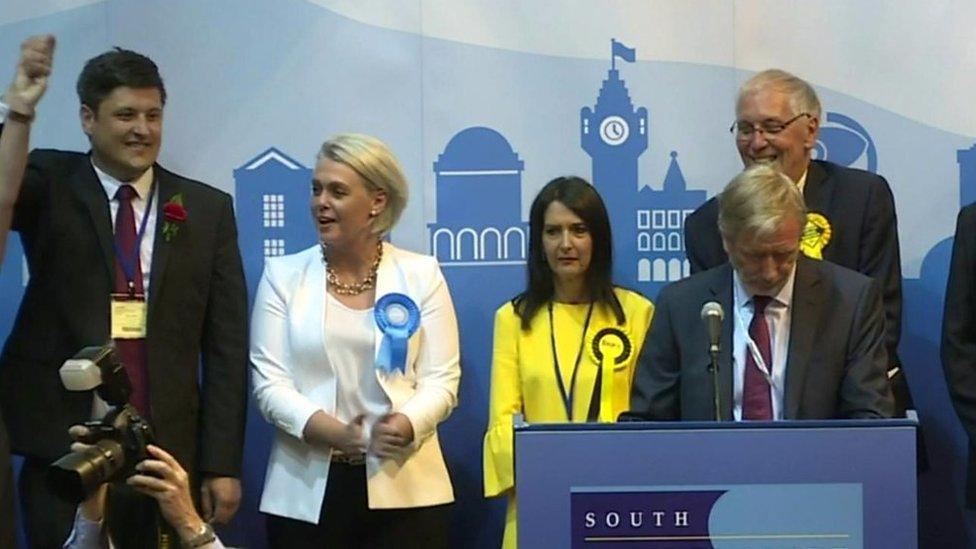
Ged Killen won the seat for Labour in 2017 - despite the party losing votes on previous years
2017 general election: Labour gain from SNP (0.5% majority)
Referendums: 55% No; 63% Remain
Target for: SNP
Contestants: Margaret Ferrier (SNP); Ged Killen (Lab); Janice MacKay (UKIP); Mark McGeever (LD); Lynne Nailon (Con)
This long-standing Labour seat was seized by the SNP in 2015, only to turn red again in 2017.
The interesting thing about the latter election was that Labour managed to regain the seat despite losing votes compared to their previous performance. It was just that they only lost 1,000 votes, while the SNP lost 11,000.
With Ged Killen defending a majority of just 265 votes - 0.5% - there will be a keen contest for the seat again this time around, with a rematch between him and his SNP predecessor Margaret Ferrier.
In a country of three-way marginals, this was one of the more two-horse races in 2017, with Labour and the SNP accounting for 75% of the vote between them. The result could tell us a lot about how both parties are performing overall in Scotland.
9. Kirkcaldy and Cowdenbeath

Lesley Laird is an ally of Labour leader Jeremy Corbyn
2017 general election: Labour gain from SNP (0.6% majority)
Referendums: 55% No; 57% Remain
Target for: SNP
Contestants: Gill Cole-Hamilton (LD); Neale Hanvey (SNP); Lesley Laird (Lab); Kathleen Leslie (Con); Scott Rutherford (Green); Mitch William (Brex)
Another prominent figure defending a potentially wobbly seat is Shadow Scottish Secretary Lesley Laird.
She has a majority of only 259 votes in her Fife constituency, which is another one which Labour reclaimed in 2017 despite actually losing votes.
If Labour have heartlands in Scotland any more, this should be one of them - the seat was formerly held with a majority of over 50% by Prime Minister Gordon Brown.
The party's goal is now to get Jeremy Corbyn into Downing Street - and seats like this will tell us a lot about whether that message has cut through in Scotland.
10. Orkney and Shetland
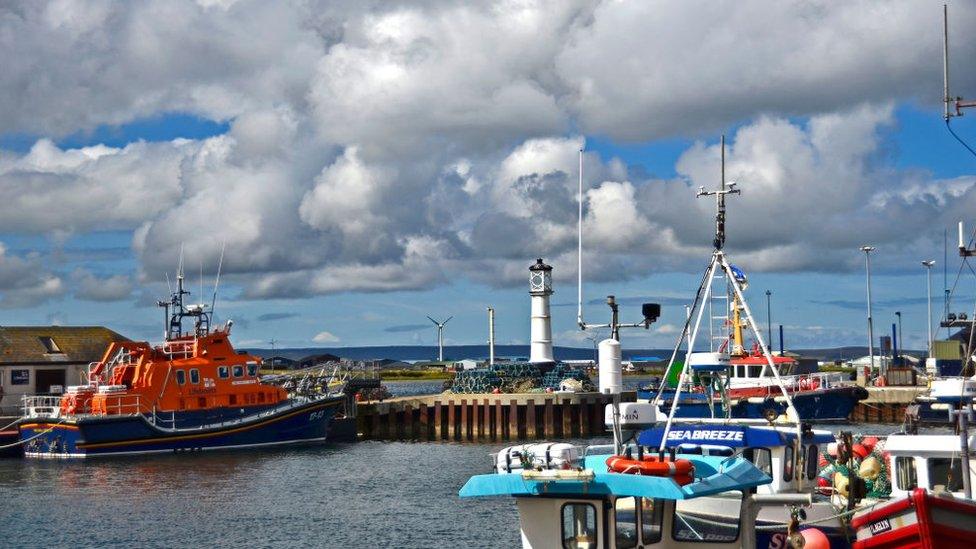
The weather is unlikey to be this good come polling day in Kirkwall
2017 general election: Lib Dem hold (19.6% majority)
Referendums: 65% No; 60% Remain
Target for: SNP
Contestants: David Barnard (Ind); Alistair Carmichael (LD); Coilla Drake (Lab); Jennifer Fairbairn (Con); Robert Leslie (SNP); Robert Smith (Brex)
By Scottish standards, Orkney and Shetland is a pretty safe seat. It's been held by a Liberal MP for all but 15 of the past 150 years, and the Lib Dems held the Holyrood seat in Shetland comfortably in a by-election in August.
MP Alistair Carmichael had a wobble in 2015, his majority dipping to 3.6% amid a Scotland-wide SNP surge, but it rose back to a healthy 19.6% in 2017 despite his having faced an election court bid to unseat him.
So what might be interesting about Shetland this time round? The turnout.
By mid-December, there are less than six hours between the sun rising and setting on Lerwick. In many places in the islands, it will be dark by 15:00.
This isn't just an issue for people heading out to vote - in the dark, in most rural areas having to travel miles to do so, quite probably in bad weather - but also for activists and campaigners who go out knocking on doors on polling day and for the weeks leading up to it.